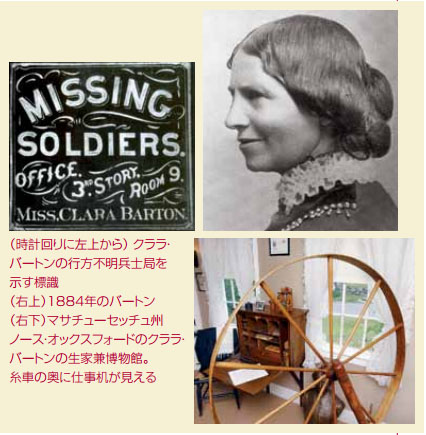国務省出版物
女性実力者の系譜-世界を広げる「クララ・ハーロウ・バートン」
 「戦場の天使」
「戦場の天使」
1821年12月25日生まれ、1912年4月12日死去
ボンネットに赤いリボン、そして濃い色のスカートという姿で南北戦争の負傷兵を看護するクララ・バートンの姿は、米国民の大半が一度は目にしたことのあるものである。しかし、戦争や自然災害の被害者に対するバートンの献身は、1865年に南北戦争が終わってからも継続した。彼女は、米国赤十字の創設者となり、何十年にもわたって米国政府にこの組織を承認するよう働きかけた。
クララ・バートンは、マサチューセッツ州ノース・オックスフォードで5人きょうだいの末っ子として生まれた。兄たちから乗馬など「男の子のすること」を教えられて育ったが、一方非常に内気な性格で家族を心配させた。大人になってからは数年間教師を務めた後、ニュージャージー州に移り、同州で初めての無料の学校(後の公立学校)を創設した。しかし、女性であるという理由でその学校の校長になることができず、ワシントンDCへ移住した。そこでは米国特許局の事務員となり、男性事務員と同じ給料を得た。これは、政府の職が女性には開かれていなかった当時としては画期的なことであった。
1861年4月12日、南北戦争が始まった。何千人もの負傷兵がワシントンに運び込まれるようになったが、政府にはその対応の準備ができていないことにバートンは気付いた。彼女は、戦場に医療品を運ぶという、前例のないこと(まして女性による前例のないこと)の許可を、1年近くにわたり政府に求め続けた。ようやく許可がおりると、彼女は南北戦争でも有数の激しい戦闘となったセカンドマナサス、アンティータム、そしてフレデリックスバーグの戦いの地へ出向き、兵士たちにとっては看護の「天使」となった。
終戦後バートンは、ジョージア州アンダーソンビルの捕虜収容所で死んだ1万3000人の北軍兵士の身元を明らかにし、墓石を作る作業を指揮した。彼女は、女性で初めて米国政府の局長(行方不明兵士局)となり、1865年から1868年までの間に2万2000人の兵士の行方を明らかにした。1869年に、バートンは医師からアドバイスを得てスイスに行き、1870-71年の普仏戦争の救援活動に参加した。そこで彼女は、戦災者に人道的な奉仕をするために1864年に創設された赤十字の組織の存在を知った。
帰国したバートンは米国赤十字を設立し、1881年5月21日に米国政府はこれを自然災害時の救援組織として承認した。バートンは米国赤十字会長を務め、1904年に引退した。彼女は、米国が1864年のジュネーブ条約に加盟すること、また国際赤十字の加盟国となることに貢献した。バートンはその人道活動によって、ドイツの鉄十字勲章、帝国ロシアの銀十字章、国際赤十字章など多くの表彰を受けている。
クララ・バートンは、メリーランド州グレンエコーの自宅で、90歳で死去した。
*上記の日本語文書は参考のための仮翻訳で、正文は英文です。
Clara Harlowe Barton - Women of Influence
Angel of the battlefield
(Born: December 25, 1821; Died: April 12, 1912)
The image of Clara Barton – tending the Civil War wounded and the dying in her bonnet, red bow, and dark skirt – is a familiar one to most Americans. But Barton's devotion to victims of war and natural disasters did not end with the war in 1865. She went on to become the founder of the American Red Cross, and worked for decades to persuade the U.S. government to recognize the organization.
Born in North Oxford, Massachusetts, Clara Barton was the youngest of five children. Her brothers taught her horseback riding and other "boyish" pursuits, but her family often fretted about her extreme shyness. Once grown up, she taught for several years, eventually moving to New Jersey, where she founded that state's first free (later public) school. Denied the chance to run the school because of her sex, Barton moved to Washington, D.C. She took a job as a clerk at the U.S. Patent Office, earning the same salary as the male clerks. This was a great achievement at a time when government jobs were not available to women.
Then, on April 12, 1861, the Civil War broke out. Thousands of wounded Union soldiers poured into Washington and Barton realized that the government was not prepared to care for them. For nearly a year, she pleaded with the bureaucracy to allow her to bring medical supplies to the field, something no one – let alone a woman – had done before. Permission finally granted, she became the nursing "angel" to soldiers in some of the war's bloodiest battles: Second Manassas, Antietam, and Fredericksburg.
Once the war ended, Barton took charge of identifying and marking the graves of the 13,000 Union soldiers who died at the Andersonville, Georgia, prisoner-of-war camp. She became the first woman to head a U.S. government bureau, the Missing Soldiers Office, and located 22,000 of the missing between 1865 and 1868. On doctor's advice, Barton went to Switzerland in 1869. She joined the relief effort during the 1870-71 Franco-Prussian War. This introduced her to the Red Cross, the organization created in 1864 to provide humane services to war victims.
Barton came home to establish the American Red Cross, which was recognized by the U.S. government to provide aid for natural disasters on May 21, 1881. She resigned its presidency in 1904. She had succeeded in getting the United States to sign the 1864 Geneva Convention and becoming a member of the International Red Cross. She received many awards for her humane work, including the Iron Cross from Germany, the Silver Cross of Imperial Russia, and the International Red Cross Medal.
She died at age 90 in her home in Glen Echo, Maryland.
For additional information, see:
Barton, Clara. National Historic Site
http://www.nps.gov/clba/
Barton, Clara. Birthplace Museum
http://www.clarabartonbirthplace.org/




